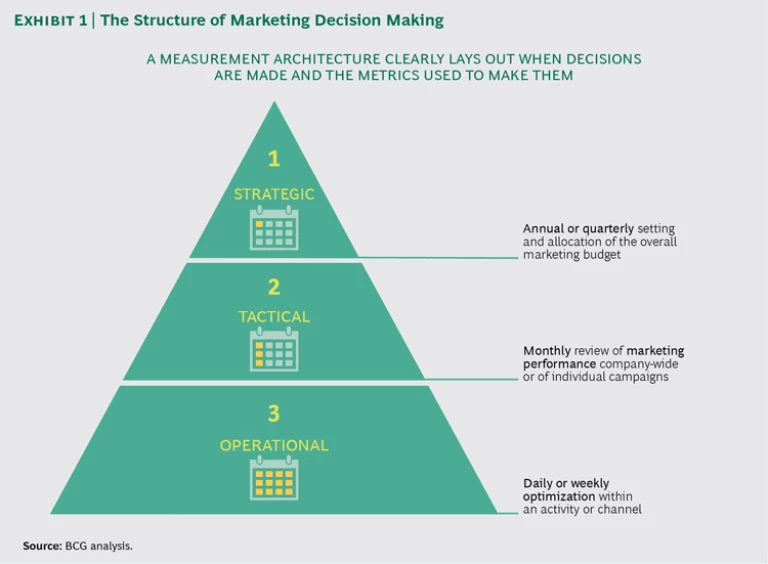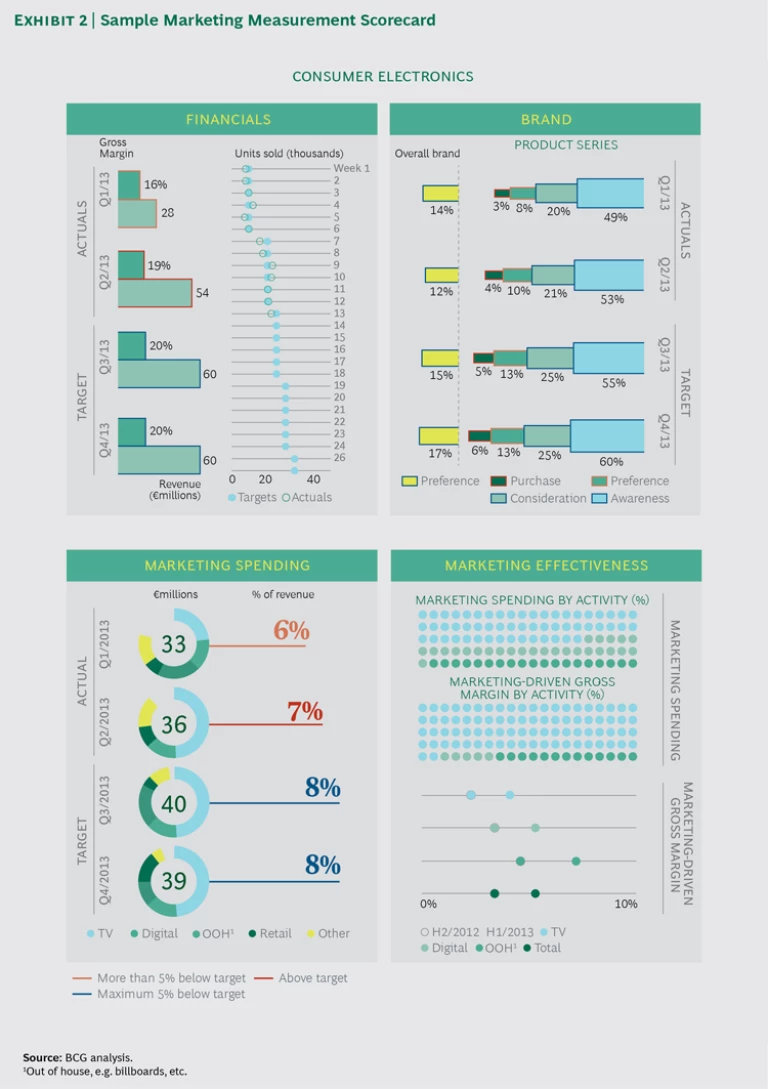Winning means keeping score, and keeping score requires a scorecard. Yet in our experience, few marketing organizations are able to quantify and communicate their contributions to such critical corporate goals as raising revenue and increasing brand recognition and advocacy. It’s not for lack of actual success. Today’s paradox is that with an unprecedented amount of data, tools, and analytics at their disposal, marketers are finding it more and more difficult to demonstrate the value that they create.
Measuring the value of marketing has never been easy. And the digital revolution has compounded the complexity, drastically increasing the number of touch points between companies and consumers while raising the expectations of senior management, among others, that everything is measurable. New tools and techniques are invented daily—the number of marketing technology vendors, each with its own way of improving reach, engaging consumers, and measuring effectiveness, has exploded from 150 in 2011 to almost 4,000 today. With marketing budgets running into the billions, it is more important than ever to know—and be able to show—what’s working.
Marketing leaders who want to demonstrate marketing’s value should take a step back, look objectively at the tools and metrics in place, and ask a few simple questions:
- Do the metrics and tools capture the short- and longer-term value of marketing?
- Do they produce answers and insights that can be acted on?
- Are they readily understood by and credible to the CEO, the CFO, and the broader organization?
If the answer to any of these questions is no, a reassessment is in order, but as they proceed, marketing leadership should avoid the temptation to aim for perfection rather than confidence. That is, instead of striving for the ideal, it is far more effective and practical to apply the necessary resources to develop and build consensus around a simple set of metrics and tools that do the job well and that will consistently demonstrate value and improvement. Here are five rules, based on our experience with hundreds of marketing organizations in many different industries worldwide, that help link measurement to real business outcomes.
Don’t Try to Grade Your Own Homework
Marketers are typically expected to justify their actions ex post and ad hoc. This often leaves them touting their worth using tools that others neither understand nor trust or citing metrics that are not broadly recognized across the business as having value.
The best way to avoid this problem is to reach a company-wide consensus in advance on a structured method of measuring the value of marketing. The burden is on marketing leaders to drive this alignment. One strategy we have seen work effectively is to establish a steering group that includes representatives not only from the relevant marketing functions but also from finance, strategy, sales, and pricing. While setting up such a structure may require more effort upfront, we find broad-based organizational acceptance is critical to creating a longer-term, sustainable marketing measurement capability.
Establish a Measurement Architecture
Any marketing department will benefit from a common measurement architecture—a decision-making framework used across the organization that matches a set of appropriate metrics (and by extension analytical tools and techniques, such as response modeling, brand tracking, and competitive benchmarking) with the most frequent marketing decisions. The measurement architecture helps sidestep another common pitfall: the tyranny of random facts, a common corporate phenomenon in which different marketing managers each cite a fact or data point revealed by some unique tool or model as evidence of the great job they are doing. It’s not that the facts are wrong; they may be totally valid. However, there is no clear way to compare one fact with another or even to know whether they are appropriate reference points for the issue at hand.
In our view, there are three types of marketing decision—strategic, tactical, and operational—that are typically made at different levels of the organization and according to different calendars. (See Exhibit 1.) Strategic decisions tend to involve the significant reallocation of marketing budgets and take place as part of the fiscal budgeting cycle. Tactical decisions typically occur many times throughout the year; they are course corrections for campaign spending levels, mix, timing, and messaging. Operational decisions, such as those concerning particular media or channels, can occur daily—or even hourly in today’s increasingly digital context. In addition, the availability of near-real-time data shifts much of a company’s focus to short-term operational priorities, which can upset the necessary balance between a short- and longer-term view of overall marketing strategy and objectives.
A measurement architecture provides marketers with a framework that defeats the tyranny of random facts by laying out which marketing decisions should be made at which time, based on which metrics, and fed by which tools and data. Once such an architecture is established, it becomes relatively straightforward to develop the analytical infrastructure to bring it to life across the entire organization. We find that many of our clients are increasingly able to focus on how to use software platforms to put data, tools, and insights into the hands of marketing decision makers at each level of the measurement architecture across brands and markets around the world.
Set Your Metrics and Tools…
Marketers can choose from a seemingly endless selection of tools and metrics, which has several consequences, few of them productive. One is uncertainty: Which tool is the best? Another is complexity: Why not use multiple tools, given that they are available? A third is complacency: marketing managers often expect the numbers to tell them what to do rather than using analytics in a hypothesis-based manner to diagnose problems and change direction.
In our experience, marketing leaders can build a simple and effective set of tools and metrics by applying three selection criteria:
- Relevance. Do the metrics or tools fit with your marketing philosophy?
- Consistency. Will the metrics create comparability over time across brands, markets, and campaigns? Consistency also advances the adoption and understanding of metrics and tools as marketers get used to seeing the same reports and formats.
- Business Value. Do the metrics reflect some broader goal? Debating the best way to measure brand consideration is pointless without broad agreement that brand consideration is valuable.
…Then Stick with Them
Everybody gets excited about the new new thing and the hope that the latest tool or technology is the silver bullet that will—finally! precisely!—prove that the marketing budget isn’t being wasted. In reality, each new tool tends to be used for a while (if at all) before being discarded in favor of some new silver bullet.
To deliver confidence in the value of marketing, the organization should take a systematic and comprehensive approach to marketing measurement. Metrics and decision tools need to be embedded into the planning processes across the organization; otherwise they will sit on a shelf and not be used. A good first step is to ensure that marketers share a common currency—a standardized set of metrics, typically five to ten, that are consistently reported and that capture short- and longer-term ROI along with a set of key contextual factors for interpreting the ROI performance, such as overall growth, relative pricing power, and share of voice. In addition to providing a means of consistent, regular reporting, a common currency enables the development of a standard toolbox across the business. A single dashboard that tracks key agreed-upon metrics in a consistent manner can be a powerful way to keep everyone focused. (See Exhibit 2.)
Of course, any standard set of metrics is only as good as the underlying data. Marketing leaders must audit and evaluate the quality of their data and its speed of delivery. They then must develop an agenda to fill key gaps or risk leaving opportunities untapped, such as realizing more sales volume from the same amount of marketing spending or driving marketing efficiencies without hurting the business. Capturing these opportunities requires leadership and discipline in embedding measurement into planning, reporting, and accountability.
Build the Right Team and Culture
As the fragmentation of activities and audiences makes measuring marketing performance ever harder, marketers must become (to borrow a term from the world of software development) more “agile,” iterating much more quickly to adapt to rapidly changing conditions. To increase this agility, marketing organizations require very different—and much more technically based—capabilities and structures than they did in the past. (See The Agile Marketing Organization , BCG Focus, October 2015.) Our research shows that the gaps and shortfalls in companies’ capabilities are bigger than many executives assume. The signs for the future are even more troubling: many marketers seem focused on catching up on yesterday’s needs rather than evolving their organizations to deliver the capabilities and expertise that will be required tomorrow. (See The Talent Revolution in Digital Marketing , BCG Focus, September 2015.)
Building the right team and culture may be the softest of the five rules, but it is also where marketing leadership can have the biggest long-term impact on the department and its role in the company.
Taken together, these five rules enable marketing leaders to shift the discussions they are having on marketing performance with their teams as well as with their C-suite peers and the broader organization. They help marketers move marketing measurement from an ex post and ad hoc treasure hunt to a system that has cross-functional, a priori organizational alignment. Ultimately, these rules can lead to a more practical means of demonstrating the value of marketing and its impact on the top and bottom lines.












